Easter Recipes from Latter-day Saints all over the World
You probably have yummy foods you always serve at Easter, and many of your recipes have been handed down for several generations. We asked Latter-day Saints from several countries to share their favorites. You have a week to gather your ingredients and try these delish offerings.
Russia — Paska Easter Bread (Kulich)
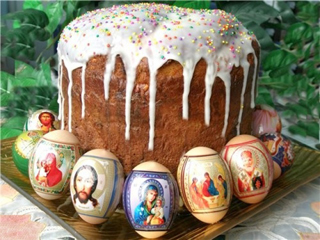 There is a folk belief in Russia that if the kulich turns out well, everything will go well at home. Thus, people take great care in making this bread and use the best ingredients. On Easter people go from house to house and generously share freshly baked bread with others. Kulich is rather temperamental, so make it with care. This recipe was submitted by Elya Ghent.
There is a folk belief in Russia that if the kulich turns out well, everything will go well at home. Thus, people take great care in making this bread and use the best ingredients. On Easter people go from house to house and generously share freshly baked bread with others. Kulich is rather temperamental, so make it with care. This recipe was submitted by Elya Ghent.
Prep time: 6 hours 30 mins
Cook time: 35 mins
Total time: 7 hours 5 mins
Ingredients:
2 cups + 2 Tbsp warm milk
6 eggs, room temp
1 Tbsp active dry yeast
2 cups sugar
2 sticks unsalted butter, (1/2 lb, or 226 gr), melted (if using salted butter, omit salt)
½ tsp salt
½ cup sour cream
1 tsp vanilla
9 cups all-purpose Canadian flour, divided
1 to 1½ cups raisins (white or brown)
For the Topping:
2 cups powdered sugar
3 Tbsp lemon juice
Colored sprinkles
What you’ll need:
3 Large Panettone Molds. You can purchase them here.
In a large mixing bowl, whisk together 2 cups + 2 Tbsp warm milk, 6 eggs, 1 Tbsp yeast, 2 cups sugar, 2 sticks melted butter (just warm, not hot!), ½ tsp salt, ½ cup sour cream and 1 tsp vanilla. Whisk in 4 cups flour. Your batter will be thick like sour cream. Cover and let it rise in a warm place or a warm oven (about 100˚F) for 2 hours.
Add 5 more cups of flour; one cup at a time or until the dough no longer sticks to your hands (it will still feel sticky but won’t stick to your fingers). I find it’s easiest to fold flour in with a silicone spatula. Dough should be soft. Stir in 1 to 1½ cups raisins. Cover and let dough rise another 2 hours in a warm oven (100˚F).
Divide dough evenly into the three baking molds; try not to mix it or stomp it down too much. Let dough rise uncovered in a warm 100˚F oven for an additional 2 hours or until the molds are almost full.
Remove from the oven and preheat oven to 350˚F. Bake at 350˚F for 30-35 minutes in the middle of the oven until the top is golden brown. Let cool to
room temp or just warm and then tear off the wrapper.
Once the breads are at room temperature and out of the molds, get your frosting ready. In a medium bowl, whisk together 2 cups powdered sugar with 3 Tbsp lemon juice. Add a little water if it’s too thick or a little more powdered sugar if it’s too runny. Pour the glaze over each cooled Easter bread. Traditionally, these are topped with colorful sprinkles before the glaze sets.
Japan — Spring Pockets (Kinchaku)
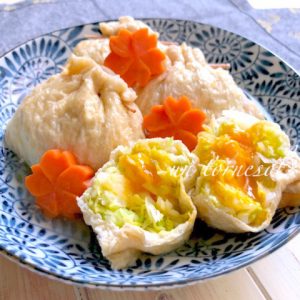 Here’s a savory dish from a country you’ve never associated with Easter. This recipe was submitted by Mami Lyon from Saitama, Japan.
Here’s a savory dish from a country you’ve never associated with Easter. This recipe was submitted by Mami Lyon from Saitama, Japan.
Ingredients:
4 Eggs (raw)
About 1/6 of a spring cabbage
3/4 tsp salt
2 slices fried tofu pouches
1 1/2 cups water
2 Tablespoons Dashi (Japanese broth)
1 Tablespoon Sake for cooking
Cut cabbage into fine strips and sprinkle salt and rubbing on it and let it sit for about 10 minutes. Drain out the water.
Cut fried tofu pouches in half and open them slowly. Then, wrap it up in a paper towel and microwave it for 20 seconds (600W).
Add pinch of cabbage in the bottom of the tofu pouches. Add one egg in each pouch, and top with more cabbage. Fold and seal tofu pouches with a toothpick. Set aside.
Pour the wet ingredients into the pot. Once it starts to boil, put the Tofu pouches into the pot and cover with foil. Let it cook for 10 minutes (low to medium heat).
Tips:
- The fried tofu has a high oil content. We recommend you lay them flat, pour boiling water on both sides. Once cool, wring out the water from each fried tofu.
- Don’t worry if there is some tearing when you open up the tofu skins.
- Crack each egg over a plate before pouring into the tofu pouches.
- Make sure to fasten them tightly by using a toothpick.
Germany — “Easter Lamb” Cake (Osterlamm)
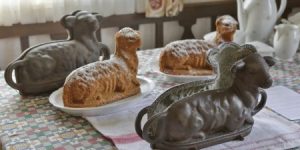 Germans paint and hide Easter eggs. On Good Friday many German Christians join Catholics in eating fish. Saturday is baking day, and on Sunday Germans can eat meat again (after Lent). In some parts of Southern Germany it’s common to bake an “Osterlamm” (Easter lamb) on Saturday. This recipe was submitted by J. Bernhard Cziesla.
Germans paint and hide Easter eggs. On Good Friday many German Christians join Catholics in eating fish. Saturday is baking day, and on Sunday Germans can eat meat again (after Lent). In some parts of Southern Germany it’s common to bake an “Osterlamm” (Easter lamb) on Saturday. This recipe was submitted by J. Bernhard Cziesla.
You will find Osterlamm molds here. For a full-sized cake, you’ll have to double this recipe.
Ingredients:
1 cup of flour
1/2 cup of butter
1/2 cup of sugar
2 eggs
1/4 cup of vanilla sugar
1/2 teaspoons of lemon flavoring
1 pinch of salt
Icing:
1 tablespoon hot water
1 1/4 cups of powdered sugar
1 ounce of shredded coconut
Mix the butter with a mixer in a mixing bowl until smooth. Gradually add the sugar to the bowl. Keep mixing. Next, add vanilla sugar, salt, lemon flavoring, and eggs while continuing to mix. Finally, mix in the flour until mixed well.
Grease the baking dish and sprinkle with some flour. Put the dough in the dish.
Preheat oven to 335 degrees Fahrenheit. Bake for 50-60 minutes. Allow lamb to cool down for 10 minutes before taking it out of the baking dish.
Lamb needs to be cool before putting on icing. Sprinkle coconut flakes onto lamb while icing is still soft. (Many people don’t use the icing and just cover the lamb in powdered sugar.)
Mexico — Mexican Bread Pudding (Capirotada)
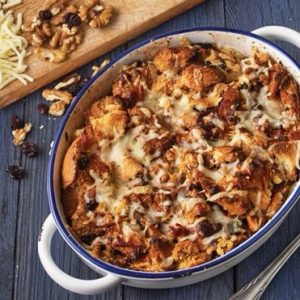 Brown sugar can be substituted for Pilloncillo and white cheese for cheddar cheese in this delicious recipe from Mexico. This recipe makes 10 servings and was submitted by Ernestina Melanie Hale. The recipe was sourced from heb.com.
Brown sugar can be substituted for Pilloncillo and white cheese for cheddar cheese in this delicious recipe from Mexico. This recipe makes 10 servings and was submitted by Ernestina Melanie Hale. The recipe was sourced from heb.com.
Ingredients:
4 cups water
2 Don Juan’s Piloncillos
2 cinnamon sticks, 4-inches long
4 whole cloves
6 bolillos, torn in 1/2″ pieces and toasted
1 cup raisins
1 cup walnuts
2 cups shredded cheddar cheese
Preheat oven to 350°F. In a medium saucepan over medium-high heat, mix water, piloncillos, cinnamon, and cloves. Bring to boil. Immediately reduce heat and simmer 10 minutes. Pour through a strainer and discard solids then set syrup aside.
Spray a 9″x13″ baking dish with non-stick cooking spray and layer with 1/3 bread pieces, 1/3 raisins, 1/3 walnuts and 1/3 cheese. Continue layering, finishing with a layer of cheese, then pour syrup over dish. Bake 30 minutes or until cheese is melted.
Italy — Neapolitan Cake (Pastiera)
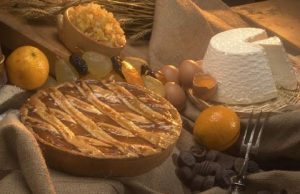 According to tradition, every family in Naples prepares Pastiera during Holy Week to be eaten on Easter day. The modern version of this cake was invented at the convent of San Gregorio Armeno. However, some trace its origins to a pagan story about the siren Partenope who would come out from the water of the Gulf of Naples every spring, delighting people with her lovely songs. This recipe was submitted by Anderson Destro.
According to tradition, every family in Naples prepares Pastiera during Holy Week to be eaten on Easter day. The modern version of this cake was invented at the convent of San Gregorio Armeno. However, some trace its origins to a pagan story about the siren Partenope who would come out from the water of the Gulf of Naples every spring, delighting people with her lovely songs. This recipe was submitted by Anderson Destro.Ingredients for pasta:
Generous 1/2 cup butter
Scant 1 cup powdered sugar
3 egg yolks
1 3/4 cups flour
Filling:
1 lb ricotta cheese
2 cups sugar
1 cup cooked Cream of Wheat
3 ounces milk
3 eggs
Grated zest of 1 lemon
1 ounce orange blossom water
Vanilla to taste
Cinnamon to taste
A little candied fruit
1 Tblsp butter
1/4 cup powdered sugar
pinch salt
Put the flour and butter into a food mixer, mix until grainy. Then blend in the yolks, the powdered sugar, the vanilla and mix further (being careful not to over-mix). When the dough is ready, wrap it in cling-film and leave in the fridge for 2 hours.
Roll the dough to a thickness of 0.2 inch, use it to line a cake pan and prick the pastry all over with a fork. Put the ricotta into a bowl with the sugar and mix together. Finish by adding all the ingredients for the filling, mixing together well, and taking care not to let it collapse. When the filling is finished lay it in the lined cake pan.
Make strips of pastry and lay them crisscross across the top of the cake like a fruit flan. Bake at 360°F for about 1 hour and 30 minutes.
CHEF’S TIPS
The filling must be particularly soft, but not too moist.
It is preferable to use a ricotta containing part ewe’s milk.
The Cream of Wheat must be well-cooked.
Before removing from the tray, wait until it has cooled enough. This is a dessert served at room temperature which requires a long preparation time.
What is characteristic about the cake is the use of the wheat and the ricotta cheese. Moreover, its characteristic aroma is based around the Millefiori essence.
Uruguay — Easter Thread (Rosca de Pascua)
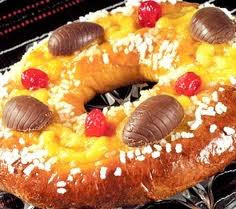 This recipe was submitted by Lucia McEwan. She was born and raised in Uruguay (South America). Her great-grandparents were from Spain, so she grew up with Spanish traditions. One of them was preparing “Rosca de Pascua” for Easter. The chocolate egg in the middle of the “rosca” represents life (being born, the resurrection).
This recipe was submitted by Lucia McEwan. She was born and raised in Uruguay (South America). Her great-grandparents were from Spain, so she grew up with Spanish traditions. One of them was preparing “Rosca de Pascua” for Easter. The chocolate egg in the middle of the “rosca” represents life (being born, the resurrection).
Ingredients:
2/3 cup milk
1 cup flour
3 Tablespoons yeast
2 Tablespoons honey
Scant 4 cups flour
1/3 cup milk
1/2 cup sugar
2 eggs
1/3 cup butter
1 Tablespoon vanilla
1 Tablespoon orange blossom water
Zest of one lemon
Crema pastelera:
Generous 2 cups milk
2/3 cup sugar
1/3 cup corn starch
6 egg yolks
1Tbsp vanilla
In a bowl mix the first four ingredients for the ferment. Cover and let it rise until it doubles in size and it looks spongy.
In another bowl, mix all the ingredients for the dough except the butter. Add the ferment, mix and knead until a dough is formed, stretch it out and add the butter and continue kneading and adding flour as needed (to avoid the dough sticking to the surface). Cover and allow to rest for 30 mins.
Cut the dough in half (to make one rosca), knead for a little bit and make a hole in the middle (creating the shape of a big donut). Place it on a pan lined with parchment paper, cover and allow it rest another 30 mins. Once it rises, brush with egg wash and add “crema pastelera” made from the 3rd group of ingredients, any desired dry fruit and nuts.
Preheat oven to 355 degrees and bake rosca for 25-30 mins. once out of the oven brush with light fruit syrup, sprinkle some raw sugar on top and add a chocolate egg in the middle.
Crema pastelera: in a large pan put the milk and half the sugar on low heat. In a bowl mix the rest of the sugar, cornstarch and yolks. Add 2 tablespoons of the warm milk mix into the cornstarch mix. Once the 2 tablespoons of the warm milk mix are well mixed with the cornstarch mix, pour it into the rest of the warm milk and sugar. stir non-stop until it thickens. Add the vanilla extract and allow it to chill in the refrigerator until it is needed.
Slovakia — Savory Cheese-Filled Roll (Syrová Roláda)
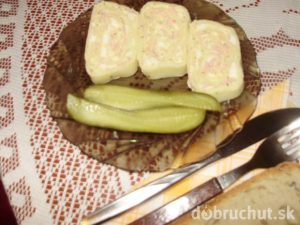 Chilled, this cheese roll is cut into slices and usually eaten with fresh bread and vegetables. This dish is found in Slovakia during Easter as well as Christmas time. This recipe was shared by Tomáš Vašíček of Prague, Czech Republic. He is from Nitra, Nitra unit, Slovakia, and will be moving back this summer.
Chilled, this cheese roll is cut into slices and usually eaten with fresh bread and vegetables. This dish is found in Slovakia during Easter as well as Christmas time. This recipe was shared by Tomáš Vašíček of Prague, Czech Republic. He is from Nitra, Nitra unit, Slovakia, and will be moving back this summer.
Ingredients:
1 lb Edam cheese
1/3 lb sliced ham
1 stick butter
Cream cheese
2 eggs, hard boiled
1 onion, diced
Dill pickles, chopped
Salt to taste
Pepper to taste
Parsley
Mix the chopped onion, pickles, and neatly sliced ham into the cream cheese. Boiled eggs are chopped and added along with salt, pepper and parsley. All is carefully mixed and filling is ready.
Meanwhile, the Edam cheese is placed in plastic bag and carefully warmed in a hot water bath until soft. Take the Edam cheese out of the hot water bath and roll out thin. Spread the filling on the Edam cheese and carefully roll up. Refrigerate for 3 -4 hours.


